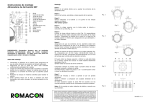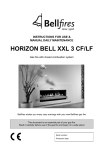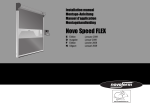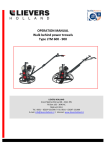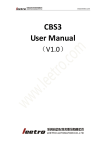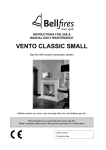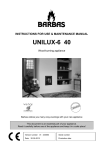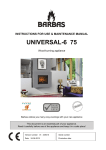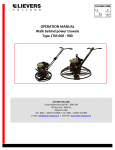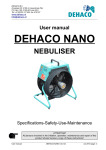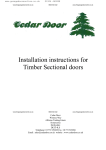Download User manual tuberailcart type HH/HM
Transcript
INSTRUCTION MANUAL Bogaerts Tube Rail Cart type BBR 010/015/020/040 HH & 010/015HM Factory: Bogaerts Greenhouse Logistics BVBA Hinneboomstraat 1 box nr. 2 B-2320 HOOGSTRATEN Belgium www.BogaertsGreenhouseLogistics.com You’re distributor : According to NEN 5509-1993 Table of Contents Instructions for Transport Introduction Operation Application and Options General Safety Regulations Technical Specifications Making Operational Usage Maintenance List of Faults Parts List Conformance Statement Type BBR 0?? ?H = tubular cart with electric/hydraulic push up wheels Type BBR 0?? ?H = tubular cart mechanical push up wheels Instruction manual p.2 1 INSTRUCTIONS FOR TRANSPORT - Caution! The tubular rail cart is somewhat top heavy. When moving it with a forklift truck: 1. 2. 3. Take the rail cart from the side. Place the forks on the inside of the small wheels. During transport, ALWAYS put the tubular rail cart in locked position. Questions about transport? Call you’re distributor. Instruction manual p.3 2 INTRODUCTION Congratulations with your purchase of the tubular rail cart. It is an excellent piece of equipment, designed and manufactured with care. To get the most out of your investment, be sure to follow precisely the instructions for its usage concerning safety, usage and maintenance. We urge you to read and follow these instructions carefully. BOGAERTS GREENHOUSE LOGISTICS cannot accept liability for damage, direct or indirect, caused by operating errors, lack of expert maintenance or other use described below. Nor shall BOGAERTS GREENHOUSE LOGISTICS accept liability for any modifications, extensions or other work on the equipment, including fittings, by you or by third parties, without written permission from BOGAERTS GREENHOUSE LOGISTICS . The tubular rail cart is subject to the general terms of delivery and payment published by Metaalunie under the title METAALUNIEVOORWAARDEN (Metal Union Terms and Conditions) or SMECOMAVOORWAARDEN (Smecoma Terms and Conditions). The original Dutch text was registered with the clerk of the district court of Rotterdam and went into effect 1 January 1992, a publication of Metaalunie, PO Box 2600, 3430 GA Nieuwegein. 3 OPERATION The tubular rail cart was designed for tending plants in market gardening greenhouses, in various stages of growth, to harvesting and transporting the harvest. The carts travel on (heating) pipes that serve as rails. The tubular rail cart has a steel construction with two steel wheels, which are electrically driven, and two nylon ones. The electromotor is powered by batteries. It drives the wheels via a reduction gear unit and chain transmission. The cart has a vertically adjustable scissors lift with a work platform. The vertical adjustment of the lifting platform takes place hydraulically. The cart also comes equipped with a vertical shaft on which a control panel is mounted, to enable the cart to drive to an operating position and to lift the work platform vertically. There is also a speed-control button on the shaft that ensures continuously variable driving speeds. The tubular rail cart has two emergency stop switches, one on the control panel and one on the driving console. Further, the undercarriage contains wheels for transporting the cart to the place where the rails start. The tubular rail wheels can be lifted off the ground using a lever (type BBR…HM) or hydraulic cylinder (type BBR…HH). The tubular rail cart has a connection for charging the batteries. Instruction manual p.4 4 APPLICATION and OPTIONS • • • • • • • • • • The tubular rail cart has been specially designed: - for checking and caring for plants efficiently in various stages of growth. - for transporting the operator to the plants. - for harvesting the products of the plants efficiently. - for transporting the harvested products or plants. The rails (heating pipes) should have a minimum diameter of 51 mm, with a minimum material thickness of 2.25 mm. In connection with stability, the possibility of tipping over and further consequences, the distance between supports should not be greater than 1.5 meters. The tubular rail cart has not been approved for transport on public roads. The tubular rail cart was designed for operating in greenhouses on stable rails. Only use the tubular rail cart for the purpose for which it was designed. Tubular rail carts should not be used to pull loads. The electrical components and wiring are drip-proof. Consequently, the tubular rail cart should be covered during overhead irrigation or spraying of plants. It should also be stored in a dry place. Only original parts and accessories from BOGAERTS GREENHOUSE LOGISTICS may be used on tubular rail carts. BOGAERTS GREENHOUSE LOGISTICS cannot accept liability for damage or consequential loss resulting from parts supplied by others. Options Article code Elebat-0029 macbre-0052 macbre-0053 macbre-0099 macbre-0056 macbre-0059 macbre-0063 macbre-0086 Item No. battery-acidmeter not standard rail diameter not standard centre distance between tubular rails built in battery indicator without time registration back and forward movement : 50% faster construction which enables the machine to be used for different center distances (only for machines designed for a center distance of 525 of 550) lower level platform battery charger Instruction manual p.5 5 GENERAL SAFETY REGULATIONS The pictographs shown below are to be seen on the equipment. You should become familiar with them and know where they stand for! Pictogram Omschrijving Caution! Before using the tubular rail cart, carefully read the instructions for use, to become familiar with the various adjustments and switches. Ordering number: BURDRW-0002 Switch the motor off by setting the main switch to >0'. Remove the rectifier plug from the power point and depress the emergency stop when doing maintenance or other work on the tubular rail cart. This will prevent dangerous situations that could arise if the cart should suddenly start moving. This will prevent the equipment from accidentally being switched on due to a misunderstanding or accident. Ordering number: BURDRW-0007 Tipping or Falling Since the operating paths between the plants must be narrow, the width or sideward stability of the tubular rail cart is also limited. - Chance of injury by falling off the cart if it becomes unstable. - Chance of injury by being buried beneath falling tubular rail cart. Make sure the rail tubes have a minimum diameter of 51 mm and wall thickness of 2.25 mm. The distance between the bottom supports of the rail tubes should be 150 cm. Instruction manual p.6 Continuation: Caution! Danger of injury due to tipping over. - maximum load 100 kg (= max. 1 person + 20kg) - maximum stacking height 100 cm - maximum lateral force 100 N • Stack carefully on top of each other. • Distribute the products equally on the work platform after checking or maintenance of the batteries or the drive • Make sure that the scissors frame has been folded away correctly, solidly supported in the under frame. • Check frequently to make sure these rules are being followed Ordering number: BURDRW-0008 Getting wedged in during adjustments to the scissors table. Caution! Danger of injury due to getting wedged in the lift arms of the work platform. The vertical adjustment should only be operated when you are convinced that no one can get wedged in the lifting platform. Ordering number: BURDRW-0005 Jamming during driving. Caution! Danger of injury from collision. Always keep a distance of two meters from the moving tubular rail cart. ALWAYS stop the tubular rail cart before loading or unloading. NEVER get on a tubular rail cart while it is moving. NEVER get off a tubular rail cart while it is moving. Ordering number: BURDRW-0004 Jamming during a collision. Caution! Danger of injury due to jamming of the chain transmission. Only work in the console when the tubular rail cart is standing still with the emergency stop button depressed. Ordering number: BURDRW-0006 Instruction manual p.7 Falling from the work platform. Using the tubular rail cart to work on plants, such as checking, trimming, binding up, spraying, harvesting, etc. requires working at great heights across a large area. There is therefore no railing to prevent falling or accidentally stepping off the platform. Caution! Danger of injury by falling from the work platform. When reaching away from the cart, always hold on to the shaft with control panel. Stand in the middle of the work platform. Always bear in mind when working that the work platform is very narrow. Ordering number: BURDRW-0003 Caution! Danger of serious injury by getting wedged between the work platform and the roof construction. Always be aware of the danger of getting wedged in during hoisting or driving. Make absolutely certain there is sufficient clearance from the roof construction. NEVER drive the tubular rail cart during hoisting. Ordering number: BURDRW-0001 • Caution! Danger of injury due to the batteries - prevent skin contact with battery acid. Wear safety spectacles. The fluid is a strongly caustic acid. On contact, wash exposed area immediately with soap and water. In case of eye contact, rinse immediately with running water for a minimum period of ten minutes and seek medical help. - make sure there is sufficient water and soap nearby, with help within vocal range, when working around these batteries. - Prevent short circuiting (spark formation) and ensure that there is no electrical connection between the poles of the batteries. - when recharging batteries, a very explosive gas is released. Make sure there are no sparks or fire around when recharging. - when recharging or storing batteries, make sure the area is well ventilated. - make sure there are no metal objects that could fall on the batteries. This could cause short circuiting or sparks and set off an explosion. - Remove personal items such as rings, bracelets, neck chains and watches, when working around the batteries. Short-circuiting charges are powerful enough to melt rings and can cause serious burns. • Caution! Hydraulic System - The hydraulic system works under high pressure. - Before working with the system, it must be depressurised. A high-pressure jet spray (to 180 bar) can easily penetrate clothing and skin, causing severe wounds and blood poisoning. Instruction manual p.8 • Caution! A tubular rail cart must be driven by a single driver, who is at least sixteen years old. - They should first carefully read the instructions for use and receive full instructions concerning the operation and safety regulations. - Persons suffering from equilibrium disturbances, dizziness or fear of heights may NOT work in tubular rail carts. • Caution: One can be injured or cause injury as a result of the following: - by not passing on the safety instructions to other operators. - by having maintenance and repair work carried out by specialists who have not been approved by Bogaerts Greenhouse Logistics nv • Caution! One can be injured if the electrical connections of the rectifier, the cable diameter, fuses, earth connection, etc. are not in accordance with regulations. • • Caution! Danger of short circuiting and fire hazard. Check plugs and electrical wiring regularly for defects. Caution! Danger of injury due to improper operation. To have a proper view of the operating panel when working with a lowered platform, the working height should not be higher than 0.5 meter. THE USER DETERMINES THE BOUNDERIES OF “WORKING SAFELY”. NEVER TAKE ANY RISK. NEVER LET THE TUBE RAIL CART DRIVE WITHOUT STANDING ON THE PLATFORM. Instruction manual p.9 6 TECHNICAL SPECIFICATIONS ________________________________________________________________ _ Length and width 1500/1700/1900 x 540/665 Track width 425/550 x tube diameter 51 mm Stacking height 520 Height of shaft 1620 Work platform l x w 1500/1700/1900 x 415 Min. work platform height 520 Max work platform height mm with length of 1,5m:2400 / length of >1,5m :3000 Weight kg 300 Maximum load kg 100 (= 1 person + 20kg) Motor output (driving) kW 0.18 Motor output, hydr. unit kW 2.2 Voltage Volt 24 DC Driving speed, 24-Volt m/min. from 1.7 to 33 Platform speed up m/min. 5,5 – 6 (depends on type, position and weight) Platform speed down m/min. 6,8 – 8 (depends on type, position and weight) Batteries Ah 2 x 110 7 mm mm mm mm mm mm GETTING OPERATIONAL • • • • • The tubular rail cart has been greased, adjusted and test driven by your supplier. When supplied, the batteries are 80-percent charged, capable of supplying eight hours of current. Check the fluid levels and, if necessary, add distilled water. Check the oil level of the electric drive. Unblock the emergency stop switch by turning the stop button to the right. Caution! The tubular rail cart may NOT be towed while the tubular rail cart wheels are engaged. This could cause serious damage to the drive. Only transport the tubular rail cart when the press-on wheels are in transport mode. Pull the lever on the shaft down or use the pressure switches (7), so that the set of wheels sticks out from under the rail wheels, for (manual) transport to the tubular rail. Instruction manual p.10 8 USAGE Make sure you are familiar with your tubular rail cart and with the operating and adjustment elements. Make sure that you or the person who will operate the tubular rail cart has read the safety regulations. Carry out regular maintenance on the tubular rail cart. Keep the cart clean. Remove any accumulated dirt. Before cleaning, push the emergency button. Only use the tubular rail cart after having studied the foregoing pages extensively and have no further questions. Maintain the cart regularly. Store it in a dry area when not in use for long periods. 1 and 7 Pressure switch, press-on wheels >press up and down=, only with BBR 010H. 2 Main switch, driving 0': the drive motor is off 1': the drive motor forward 2': the drive motor reverse 3 Speed-control button clockwise = faster 4 Pressure switch, lift table down 5 Pressure switch, lift table up 6 Optional switch, driving with foot switch 7 only with BBR…HH: 8 Emergency stop switch hydraulic lifting of transversal wheels Operating Sequence Instruction manual p.11 Caution! The switches may only be used when you are on the lift platform. Optional switch (6) up. 1 Check to see that the main switch, drive, (2) is in the >0' position. 2 Place the speed-control button (3) in the middle position. 3 Place the optional switch (6) in the >up= position. 4 Change the main switch, drive, (2) from >0' to desired direction. 5 Depress foot switch. The cart will start driving. 6 Release the foot switch and the cart will stop. 7 Adjust the desired speed using the speed-control button (3). Counterclockwise = faster, clockwise = slower Optional switch (6) down. 1 Check to see that the main switch, drive, (2) is in the >0' position. 2 Place speed-control button (3) in the middle position. 3 Place the optional switch (6) in the down position. 4 Depress and hold the foot switch. 5 Change the main switch, drive, (2) from >0' to desired direction. 6 Release the foot switch and the cart will start driving. 7 Set the desired speed using the speed-control button (3). Counterclockwise = slower, clockwise = faster 8 Depress the foot switch and the cart will stop. Change the main switch, drive, (2) to >0' and then release the foot switch. Caution! Prevent serious damage. - ALWAYS first place the main switch, drive, (2) in the >0' position. - Never change the main switch directly from >1' to >2' without first switching to >0'. Wait until the cart has stopped, then switch to >2' and vice versa. - Wait until the cart has stopped before getting on or off. NOTE After use • ALWAYS set the main switch (2) in the >0' position. • Press the emergency stop button. Instruction manual p.12 9 MAINTENANCE 9.1 Grease and maintenance schedule d = daily m = monthly o = oil w = weekly a = once a year g = grease To Do fluid o/g freq. 1 check oil level of reduction gear unit DD30 o m 2 check oil level of the hydraulic unit Hyd.46 o m 3 check battery charge, depending on intensity of use w 4 check battery fluid dist.water w 5 replace oil, variable speed gear DD30 3/4 liter a 6 clean carbon brushes, electromotor a 7 replace carbon brushes when length is less than 1 cm. 8 hinged parts g m 9 lifting wheels and rotation points of scissors lift g m 10 clean foot switch d 9.2 Technical maintenance Maintenance and repairs to the parts listed below must be carried out by a specialist firm apointed by the manufacturer.: All work on electrical components and wiring. All work on the hydraulic system. All work on the electric drive motor with reduction gear unit, except: - checking oil levels and changing the oil. - cleaning, re-setting or replacing the chain and sprocket chain wheel Depending on the maintenance schedule, section 8 and intensity of use, it would be advisable to have maintenance carried out regularly, at least once a year. 9.3 Maintenance of the batteries For complete product information about these batteries, please contact Bogaerts Greenhouse Logistics nv. Here are several tips for the use and maintenance of batteries - the battery fluid should be checked weekly. It should be at least 1 cm above the plates. Use only distilled water to fill. - the specific gravity of the acid should be checked weekly using an acidmeter. When fully charged, the density of the batteries should equal 1.28 kg/l. - Percentage Density (kg/l) Tension (V) 100% 1.28 12.7 80% 1.24 12.5 60% 1.21 12.3 40% 1.17 12.1 20% 1.14 11.9 Recharging batteries immediately when empty, substantially increases battery life. Allowing the batteries to discharge below 20 percent will negatively affect battery life. Instruction manual p.13 - Before recharging batteries, first connect the batteries to the charger, then switch on the charger. After recharging, first switch off the charger, then disconnect the batteries. The gases released during the recharging of the batteries are highly explosive. Make sure there are no sparks or fire close to the place where the recharging takes place. Recharging should only take place in a well ventilated area. Overcharging the batteries could damage them, since the battery fluid will continue to boil for a time. Using a modern battery charger with automatic shut-off switch is recommended. Never disrupt recharging. Wait until recharging is completed. Do not repair, clean or work on the tubular rail cart during recharging. Before removing the batteries, always turn off all electrical devices first (to reduce the risk of spark formation) When removing the batteries, first remove the earth cable (-). When installing them, the earth cable should be connected last. Caution! Always hook positive (+ = red) to positive and negative (- = blue) to negative. Battery fluid is a very aggressive acid. Avoid contact with clothes, skin or eyes. If battery acid should accidentally splash on clothes or skin, wash immediately with water and soap, then rinse thoroughly with water. If acid should accidentally get into the eyes, rinse for at least five minutes with clean water and immediately consult a doctor. When replacing the batteries, the used batteries must be turned in at the point of purchase or at a municipal battery dump. For more detailed information about these batteries, please contact you’re distributor. Instruction manual p.14 10. LIST OF FAULTS 10.1 General remark If any defective parts is found on the tubular rail cart, do not use the cart until fully repaired. You can first check if you can easily repair the cart yourself (with the help of the failure list that can be found a bit further in this document) or you can directly contact BOGAERTS GREENHOUSE LOGISTICS bvba or its dealer in your country. Before contacting Bogaerts Greenhouse Logistics nv or its dealer, make sure you write down all the useful information you’ll find on the CE-plate that can be found on the right hand side of the aluminium platformpile Instruction manual p.15 Fault Solution ___________________________________________________________________________ A The tubular rail cart will not drive. 1 Batteries are empty. 1 Recharge batteries 2 Emergency stop button depressed 2 Reset emergency stop 3 Battery clamps do not make good contact 3 Clean and reposition them 4 Break in cable of foot switch 4 Replace cable 5 Defective foot switch 5 Replace switch 6 Defective reversing switch 6 Replace switch 7 Other problem 7 Consult your dealer B The scissors table will not go up / down 1 Batteries are empty 2 Emergency stop depressed 3 Too heavily loaded 4 Too little hydraulic oil 5 Battery clamps do not make good contact 6 Collector motor is dirty or worn 1 2 3 4 5 6 Recharge batteries Reset emergency stop Reduce the load Add hydraulic oil Clean and reposition them Clean or replace C The tubular rail cart only works now and then 1 Loose wiring 2 Carbon brushes dirty or worn 1 3 4 3 4 Check wiring 2 Clean or, if lengths are less than 1 cm, replace Clean, revise or replace clean or replace 1 2 Tighten button Have printing plate replaced Collector motor is dirty or worn Relays do not switch in properly because they are dirty or defective D The speed is difficult to control 1 The button on the operating panel is loose 2 The printing plate in the operating panel is defective Instruction manual p.16 11 PARTS Item Name Code no. ___________________________________________________________________________ 1 Drive motor elemot-0005 2 Variable speed controller elestu-0001 3 Drive chain aadket-0004 4 lock for drive chain aadket-0003 5 Standard operating panel, complete hafbre-0019 6 Main switch on-off elesch-0010 7 Main switch on-off key elesch-0011 8 Press-on wheel aadtrw-0001 9 Speed control (potentiometer) elewee-0002 10 Main switch (>1 - 0 -2') elesch-0003 11 Noodstop compleet elesch-0022 12 Battery elebat-0002 13 Fuse 30A elezek-0004 14 Fuse 50A elezek-0005 15 Fuse 80A elezek-0007 For a more elaborate list of parts, ask your dealer for our photo-partslist Instruction manual p.17 12 CONFORMANCE STATEMENT Tubular rail cart Model BBR…………… Date of Final Inspection ………………………… Serial number(-s) ………………………… BOGAERTS GREENHOUSE LOGISTICS NV, HINNENBOOMSTRAAT 1, 2320 HOOGSTRATEN BELGIUM hereby states that the above tubular rail cart(-s) meets the Machinery Guideline provisions (Directive 98/37/EEC, latest revision). HOOGSTRATEN, Signed by the Managing Director BOGAERTS GREENHOUSE LOGISTICS NV Instruction manual p.18 JORIS BOGAERTS


















